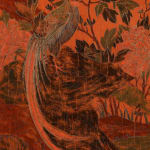A TIAN QI AND JIANG JIN RED LACQUER TABLE
W: 64.5" / 164cm
D: 19.6” / 50cm
Further images
Provenance
Private Collection West Coast USA.
Private Collection London UK.
Literature
Robert Rousset Collection, Musee Guimet Paris (illustrated here)
Rousset Collection, sold Bonhams 25th October 2022 € 1,482,375
David W.Reierson: Sold Bonhams 2nd December 2021 HK$ 2,252,500
Private Collection: Sold Beaussant Lefevre 8th November 2022, € 524,800
Private Collection: Sold Bonhams 9th November 2017, £ 248,750 (Huanghuali of identical form)
Private Collection: Sold Christies 22nd November 2022 € 579,600 (Mother of Pearl of identical form)
Publications
The Palace Museum Collection, A Treasury of Ming & Qing Dynasty Palace Furniture (I). Palace Museum Beijing 2007. Vol 1. pg. 253. Fig 289.
Chinese Furniture from the Ming Period to the 20th Century. Michael Beurdeley. Fig 154
R. H. Ellsworth, Chinese Furniture: One Hundred Examples from the Mimi and Raymond Hung Collection, New York, 1996, pp. 164-5, no. 61.
G. Ecke, Chinese Domestic Furniture, Vermont and Tokyo, 1962, p. 46, pl. 361.
An Exceptionally Rare Red-Lacquer “Character One” Table with Polychrome Decoration, Ming Dynasty (16th–17th Century)
This outstanding recessed-leg table—lacquered in a luminous vermilion and intricately decorated in shades of black, green, and gold—is a rare surviving example of a form and technique that typifies the pinnacle of Ming dynasty lacquer craftsmanship. With its elegantly restrained proportions, refined joinery, and complex surface decoration, it represents a near-ideal synthesis of structural integrity and painterly ornament.
The table’s flat rectangular top is incised with a dynamic landscape of trees, birds, rocks, and floral sprays, all arranged over a densely diapered ground. The design flows with natural rhythm, animated by fine lines, subtle colour modulation, and expertly balanced asymmetry. The decoration continues across the shaped aprons, side and corner spandrels, and round-section legs, which retain their full original length and terminate in dark-lacquered feet. The double side stretchers—each lacquered with floral sprays—are delicately proportioned, and the entire construction displays the classic “character one” (yi zi) form: an elegantly horizontal silhouette derived from the single stroke of the Chinese character for “one” (一). This form, developed during the Song dynasty and refined during the Ming, reflects a philosophy of harmony, balance, and simplicity, executed here with rare distinction.
Technically, the table is a masterful demonstration of the combined qiangjin and tianqi lacquer techniques—highly skilled and laborious methods typically reserved for objects of the highest status, often intended for imperial or aristocratic use. Qiangjin, meaning “engraved gold,” involves the delicate incision of fine lines into the lacquer surface, which are then filled with gold. Tianqi refers to the precise application of coloured pigments within defined areas, creating a richly layered polychrome effect. The use of both techniques on a large-scale, functional piece of furniture is exceptionally rare. That they survive here with such clarity and integrity is a testament to the table’s outstanding craftsmanship and the superior quality of materials employed. Polychrome lacquered tables of this scale and completeness are seldom preserved—particularly with an original surface so intact—making this an exceptional and important survival.
Closely related lacquered tables can be found in the collection of the Palace Museum, Beijing, including a group of red and polychrome recessed-leg examples dating to the Wanli period. Another comparable example, with similarly fine qiangjin and tianqi decoration, is in the Metropolitan Museum of Art, New York (Acc. no. 2006.251.3). The Victoria and Albert Museum also holds a related black-lacquer recessed-leg table from the Ming period (Museum no. FE.75-1975), though few examples outside China survive with polychrome surfaces of this quality and completeness.
Lacquered tables of this type were most commonly produced in the late Ming period, particularly under the Jiajing (1522–66) and Wanli (1573–1620) emperors, and were intended for elite scholarly or domestic interiors. Though often documented in paintings and literature, extant examples are exceedingly scarce. This table ranks among the finest known for its combination of bold silhouette, elegant joinery, and intricate pictorial decoration, making it a museum-quality piece that embodies the intellectual and artistic ideals of the Ming literati.







